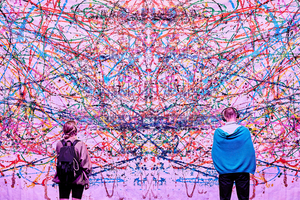Review: The Festival d'Avignon Presents UNA IMAGEN INTERIOR By El Conde de Torrefiel
The insights of Pablo Gisbert's texts are at times profound.

The text of Una Imagen Interior, a production by Spanish company El Conde De Torrefiel now in performance at Vedène's Autre Scène du Grand Avignon, is relegated to a bilingual surtitle board. Who does your mind cast in this role of narrator? A whimsical and childlike Björk might be appropriate. A resonant and poetic Maya Angelou might also work. My mind landed on the professorial tenor of David Attenborough. He was a good companion in a work that aspires to transcend "frames."
The piece begins with a large painted tarp on the stage. It looks either like a lesser Pollock or Rorschach's best. The tarp is raised for us to see. The surtitle board springs to life with word association. Words like "Stage," "Theatre," "Avignon," and "Heat" rapidly pass by. It then describes the stage action. We are then informed that we're at a museum and this work is thousands of years old. This painting is, importantly, not a work of religious meaning, but made for its own communal ends. We are introduced to a few of the museum guests milling about the stage. We are told what brought them there, their reaction to the art, and a bit about their personality.
The painting is removed for the second scene, which takes place in a supermarket. The surtitling ponders, "How did all of this get here? This world used to be a desert." An influencer is having a hard go of it with all their travel and stress. Two people chat; one presumes the other to be an employee. They leave the stage. It is at this time that abstract sculptures that resemble fleshy alien mounds buzz around. The first few are very small, though one is as large as a person. The word "Abstract" is added to the cavalcade of vocabulary flashing on the screen.
The text contemplates about "fictions." These fictions include politics, identity, and religion. It also includes more seemingly concrete things like shapes. "I don't believe the square exists in nature." I start to chuckle to myself as, at least in my mind, David Attenborough seems to have ingested more than he anticipated. A group of hip looking performers in shades and leather enter the space. These are the text's "friends." They hold their own ritual. Together they then spread out a white tarp on the ground and spray paint on it. The tarp is then folded, and squished, creating a painting that, I imagine, will open the next performance. It is raised for us to see.
The insights of Pablo Gisbert's texts are at times profound. His philosophy is a bit more undergrad stoner than Hamlet, but in that lays the charm. Manoly Rubio Garcia's lighting, particularly in how it transforms the painting in the start, is wonderfully poetic. It takes great advantage of the otherwise maligned "frames." Sound by Uriel Ireland and Rebecca Praga is more engaging and curious than almost anything you're likely to find in the US.
For a piece that is so adamant about releasing ourselves from constraint, we are never given much to aspire to. That the people in the museum and the grocery store were cold and distant is in keeping with the work's thesis. Though I couldn't sort out why everyone seems to have taken The Matrix's red pill as they, with much seriousness, spatter paint on tarp. The work advocates for intimacy and community, though in the end their cast members seem as distant from one another as museum goers. Is this coolness our reward for transcendence?
Photo Credit: Christophe Raynaud de Lage
Reader Reviews
Videos

